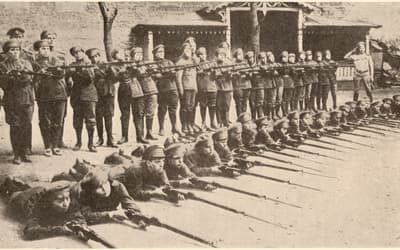The views expressed in this paper are those of the writer(s) and are not necessarily those of the ARJ Editor or Answers in Genesis.
Abstract
The Cambodian genocide that resulted in the loss of an estimated two million lives was reviewed. Of the many causative factors involved in causing the genocide, this paper focused on the important influence of social Darwinism. Pol Pot’s background, and the persons that were important in developing his political philosophy, including Joseph Stalin and Mao Zedong, were also briefly reviewed, focusing on his acceptance of both social Darwinism and communism.
Keywords: social Darwinism, genocide, Cambodia, Pol Pot, communism, racism, survival of the fittest, natural selection
Introduction
Darwinism teaches that natural selection (survival of the fittest) morphed into social Darwinism due to the influence of Herbert Spencer and Francis Galton, who founded the field of eugenics. Galton’s cousin, Charles Darwin, also actively supported eugenics. Social Darwinism claims that peoples—races, ethnicities, classes, and nationalities—are in a life and death struggle for resources and power. Social Darwinism, therefore, teaches that the weakest are eliminated from the gene pool through war, starvation, or purposeful extermination. The fittest survive while the weakest are vanquished and eliminated.
This paper outlines the tragic effects of social Darwinism as applied by Pol Pot (1925–1998) to Cambodia. The death of Cambodia’s Marxist dictator named Pol Pot (his birth name was Saloth Sâr) on April 15, 1998, ended one of the world’s worst mass-murder nightmares. The horror stories of what happened when the communists took control of Cambodia’s government rival the WWII Nazi racial policies (Stagg 1998).
Beginning in 1975, Pol Pot led the communist Khmer Rouge to commit genocide against his own people in a bloodthirsty regime inspired by Stalin and China’s notorious Mao Zedong. The Khmer Rouge was the popular name given to the Communist Party of Kampuchea which ruled Cambodia from 1975 to 1979.
The Education of Pol Pot
Pol Pot’s reclusive nature plus his concealment and falsification of many details make much of his life difficult to reconstruct in much detail (Mikaberidze 2013, 532). It is known that he was the son of a prosperous farmer in French Cambodia, and was educated at several of Cambodia’s academically leading schools. He was also part of the small Cambodian elite that was able to further his education in France. It was in Paris from 1949 to 1953, as a scholarship-recipient student that Pol Pot would be influenced by the evolutionary ideas taught by Professor Sartre and his French intellectual elites.
When the “French intellectual Jean-Paul Sartre made his dramatic switch to support the Soviet Union in 1952 he began a major social movement” (Becker 1998, 56). This movement transformed the young Cambodian university students in France, including Pol Pot to militant Marxists (Talbot 2009). Consequently, Pol Pot joined the French Communist Party around 1952, a decision heavily influenced by the writings of Jean-Jacques Rousseau and Joseph Stalin, the former Tiflis Theological seminarian turned atheist by reading the works of Charles Darwin (Yaroslavsky 1940, 8–9). Stalin’s writings were leading political primers used by communist parties all over the world. Mao even had Stalin’s writings translated into Chinese, and Ho Chi Minh sponsored a Vietnamese translation (Short 2004, 67).
Stalin’s approach to Marxism—known as Stalinism—inspired Pot and gave his life a sense of purpose (Short 2004, 66). Specific ideas that Stalin advocated, (with which Pot agreed), included the importance of purging from the party the less enthusiastic members and those that resisted the parties growth (Short 2004, 67). Pot was also impressed with Stalin’s aggressive no-holds barred implementation of communism. In the end, Short concluded that Stalin had a crucial influence causing in the genocide of Cambodia.
The Importance of Race
Another factor influencing the Cambodian genocide was race, which far overshadowed the importance of class in Cambodia (Kierman 2002). In fact, when Pot met with China’s leader, Mao Zedong, he explained his goal was to follow China’s lead in adopting the race ideas of, not only Darwin, but also of Darwin’s outspoken British supporter, Thomas Henry Huxley. (WCDA 1975). Huxley was well known as “Darwin’s Bulldog” Chairman Mao listed Darwin and his disciple T. H. Huxley as two of his favorite authors and passed their ideas to Pol Pot (Hall 2005, 46). In fact, the two “most important themes in the history of the Pol Pot regime are the race question and the struggle for central control . . . [and, for the] Khmer Rouge conceptions of race overshadowed those of class” (Kierman 2002, 26).
In 1953, attempting to find a communist movement he could work with and support, Pol became involved in the Marxist-Leninist Khmer Việt Minh organization and their guerrilla war against King Norodom Sihanouk’s newly independent Cambodian government. Sihanouk’s government was recognized by the 1954 Geneva Conference as a political settlement to the First Indochina War. At this time, Pol Pot returned to Phnom Penh to teach school while remaining a central member of Cambodia’s Marxist-Leninist movement. Pol Pot eventually was promoted to the position of Cambodian party chief.
Social Darwinism and Pol Pot’s
Cambodian “Master Race”
Professor Jean-Paul Sartre, whom we noted had a major influence on Pol Pot, taught that evolution produced higher forms of life as a result of the evolutionary struggle. British Historian Paul Johnson wrote that Sartre’s
influence on South-East Asia, where the Vietnam War was drawing to a close, was even more baneful. The hideous crimes committed in Cambodia from April 1975 onwards, which involved the deaths of between a fifth and a third of the population, were organized by Pol Pot’s group of Francophone middle-class intellectuals known as the Angka Leu (“the Higher Organization”). Of its eight leaders, five were teachers, one a university professor, one a civil servant, and one an economist. All had studied in France during the 1950s, where they had not only belonged to the Communist Party but had absorbed Sartre’s doctrines of philosophical activism and “necessary violence.” These mass murderers were his ideological children . . . . In the end he [Pol Pot] stood for nothing more than a vague desire to belong to the left. (Johnson 1989, 71–72)
Pot applied this idea of struggle to Cambodia, concluding that his race was the master race. With one exception, discussed below, he judged all the 20 Cambodian ethnic groups as inferior (Artsemerson 2019). The result was that “Pol Pot’s attempts to create a Cambodian ‘master race’ through social engineering . . . ultimately led to the deaths of more than two million people in the Southeast Asian country” (History.com editors 2017). Of course, other factors also existed that may have influenced the Cambodian holocaust, but this review focuses on the critical importance of race and ethnicity.
At this time, the newly formed Khmer Rouge guerrilla army launched a national uprising in 1968. They were eventually able to gain a foothold in the sparsely populated northeast. By August 1973, the number of Khmer Rouge troops increased exponentially until they controlled close to three-quarters of Cambodia’s territory. A final assault of the refugee-filled capital began in January 1975, and on April 17, 1975, the Khmer Rouge was victorious, ending the civil war. Pol Pot next worked to transform Cambodia into a one-party state that he named Democratic Kampuchea.
Darwin’s Influence in Democratic Kampuchea
Engels and Marx, Lenin and Trotsky, Stalin and Mao Zedong all embraced in some measure, and in various ways, Darwin’s theory of natural selection as a justification for the sometimes brutal class/ethnic struggles that occurred in their societies (Johnson 2012, 122). Furthermore, the “enthusiastic embrace by Marxists of Darwin’s theory is a matter of public record” (Flannery 2012, 2).
This embrace by Marxists of Darwin’s theory was thoroughly documented in Chris Talbot’s three-part essay, “Marx and Darwin: Two great revolutionary thinkers of the nineteenth century” posted at the World Socialist Web Site (Talbot 2009). In short, “Cambodian Pol Pot’s belief in Darwinism led him to kill millions of people he thought were genetically inferior or lesser races so that he could stop them from breeding and make a better Cambodia” (Estrada and Newkirk 2013, 55). Because of where different people groups lived, the goal of the elimination of inferior people tended to result in urban-rural conflicts (Johnson 2012, 136).
The end result was that over one-fourth of the Cambodian population was murdered. Even today, the exact number is unknown due to attempts by the Khmer Rouge to hide the true extent of the massacre. Under the subtopic “Evolution’s Cruel Legacy,” Chalfant writes: “Evolution served as the rationale for the genocidal tyrannies of men such as Joseph Stalin, Adolf Hitler, Mao Tse-tung, Cambodia’s Pol Pot, and Kim Jong II of North Korea, to name a few of the most recognized” men (Chalfant 2003, 68).
The Importance of Darwin to Communism
The importance of Darwinism to communism was detailed by Chris Talbot who wrote that
it may seem there is not much of a connection between Darwin, the retiring English gentleman, and Marx, who along with Friedrich Engels, was involved in revolutionary communist activity for most of his adult life. But Marx and Engels themselves immediately recognized the significance of Darwin’s theory when On the Origin of Species appeared 150 years ago. Engels wrote to Marx in 1859, just after he had read the first edition of Darwin’s book. (Talbot 2009)
Marx’s compatriot Friedrich Engel, looking for ways to defend his atheism, considered Darwin’s ideas
absolutely splendid. There was one aspect of teleology [proof for God] that had yet to be demolished [that is, the concept of design in nature], and that has now been done [by Charles Darwin]. Never before has so grandiose an attempt been made to demonstrate historical evolution in Nature, and certainly never to such good effect. (MECW 1929, 550)
The Superior Race
The Khmer race was considered by the dominate Khmer Rouge people as the superior race. Furthermore, race even “overshadowed organizational imperatives. Non-Khmer Cambodians . . . were removed from the leadership and usually murdered” (Kierman 2002, 26). The non-Khmers at the bottom of the social ladder were “singled out for persecution because of their race.” Even those persons ‘tainted’ by non-Khmer traits suffered “class and racial hatred” (Lowery and Bergin 2016, 33). Membership in the single approved race was a condition, but not a sufficient factor, to obtain official approval from the Communist Party of Kampuchea.
The problem was that the “inferior race” classification was originally intended for “Chams.” The Champa people were an “Austronesian ethnic group considered to be an inferior race, for racial reasons rather than geographical ones” (Kiernan 2002, 259). Furthermore, “the parallel ‘blood’ concepts of race and kinship” were central in Kampuchea Communist Party ideology and practice (Kiernan 2002, 259).
According to the 1948 UN Convention genocide is defined as “acts committed with intent to destroy, in whole or in part, a national, ethnical, racial, or religious group,” whether by way of murder, physical or psychological trauma, or preventing reproduction. (Lowery and Bergin. 2016, 4). The word “genocide” was used no less than 90 times by Kiernan in his book on Cambodia and the Khmer Rouge.
The so-called Democratic Kampuchea “forces even massacred Vietnamese civilian refugees” based on their race (Kiernan 2002, 460). The reason was the Vietnamese were also considered an inferior race. This is why the “Kampuchea waged a campaign of genocide against ethnic Vietnamese” (Kiernan 2002, 460). The specific reason for this was that “Racism and xenophobia produced an annihilationist ideology that depicted Cambodia’s ethnic Vietnamese minority as a deadly internal threat to the survival of the Khmer nation” (Jones 2006, 191). In addition, “almost every ethnic minority in Cambodia” was also targeted for annihilation (Jones 2006, 190). There was one exception, which was because “Pol Pot came to admire the tribes in Cambodia’s rural northeast” (History.com editors 2017). The reasons he admired them include the fact that
These tribes were self-sufficient and lived on the goods they produced through subsistence farming. The tribes, he felt, were like communes in that they worked together, shared in the spoils of their labor and were untainted by the evils of money, wealth and religion. (History.com editors 2017)
Pol Pot used the model of these rural tribes in his attempt to achieve his goal of creating a communist-style, agricultural utopia.
Summary and Conclusions
When Pol Pot learned about Darwinism, Darwin’s “theory so interested dictator Pol Pot that he decided to improve the genetics of the Cambodian people by wiping out two million people that, in his view, had inferior genes, [in order] to stop them from breeding and [as a result] make the Cambodian people genetically superior to others . . . .” (Estrada and Newkirk 2013, 169–170). In Pot’s view, these two-million persons that had inferior genes must be stopped from breeding and spreading their inferior genes (Estrada and Newkirk 2013, 169–170). Estrada and Newkirk add that “there is no empirical evidence that, after two million deaths . . . the people’s genetics got better” and are now genetically superior (Estrada and Newkirk 2013, 170).
Paul Johnson concluded that, in all, “In the twentieth century, it is likely that over 100 million people were killed or starved to death as a result of totalitarian regimes infected with varieties of social Darwinism” (Johnson 2012, 136). One of these examples of a totalitarian regime infected with Darwinism was that of Pol Pot (Xun 2018). Pol Pot is also listed as causing one of the twentieth century’s worst eugenically driven murderous genocides (Garrett 2019, 196). As one victim of Khmer rule stated, “these savage people tried to wipe out our race” (de Nike, Quigley, and Robinson 2000, 155).
Kiernan concluded in his massive study of the genocide in Cambodia under the Khmer Rouge that the results of the unbridled evil of racism which resulted from accepting a racist Darwinian worldview left over two-million dead (Kiernan 2002, 465). The Pol Pot government “betrayed the nation, the people, and the revolution, and they applied a policy of exterminating [even certain minorities of] the Khmer race, a policy more wicked and savage than that of Hitler” (de Nike, Quigley, and Robinson 2000, 305). The History Channel editors have provided an excellent summary of the end results of Pol Pot’s attempt to apply social Darwinism to Cambodia:
Pol Pot’s attempts to create a Cambodian “master race” through social engineering ultimately led to the deaths of more than 2 million people in the Southeast Asian country. Those killed were either executed as enemies of the regime, or died from starvation, disease or overwork. Historically, this period—as shown in the film The Killing Fields—has come to be known as the Cambodian Genocide. (History.com editors 2017)
In May 1993, the first free elections in more than 20 years were held in Cambodia. In January 2001 the new Cambodian government established a tribunal to try the Khmer Rouge leadership for crimes against humanity. Trials began in 2009 but led to only three convictions, including the commander of the S21 prison, who was sentenced to life in prison. The vast majority of the eugenic perpetrators did not suffer any consequences for their killings and major violations of human rights.
References
ArtsEmerson. 2019. “A Brief History of the Khmer Rouge.” https://artsemerson.org/2019/05/10/a-brief-history-of-the-khmer-rouge/.
Becker, Elizabeth. 1998. When the War Was Over: Cambodia and the Khmer Rouge Revolution. Rev. ed. New York, New York: Public Affairs.
Chalfant, John W. 2003. America: A Call to Greatness. Winter Park, Florida: Xulon Press.
De Nike, Howard J., John Quigley, and Kenneth J. Robinson. eds. 2000. Genocide in Cambodia: Documents from the Trial of Pol Pot and leng Sary. Philadelphia, Pennsylvania: The University of Pennsylvania.
Estrada, James, and Willie Newkirk Jr. 2013. God’s Cops. Bloomington, Indiana: Xlibris Publishing.
Flannery, Michael. 2012. “Let’s Not Be So Quick to Dismiss Paul Johnson’s Darwin.” Evolution News & Science Today. December 2. https://evolutionnews.org/2012/12/lets_not_be_so/.
Garrett, Gregory L. 2019. The Flat Earth: Trilogy Book of Secrets II. Hollister, California: Gregory Garrett Publishing.
Hall, Raymond. 2005. “Darwin’s Impact—The Bloodstained Legacy of Evolution.” Creation 27, no. 2 (March): 46–49.
History.com editors. 2017. “Khmer Rouge.” History.com, September 12. https://www.history.com/topics/cold-war/the-khmer-rouge.
Johnson, Paul. 1989. “Jean-Paul Sartre: ‘A Little Ball of Fur and Ink.’” The Wilson Quarterly 13, no. 2 (Spring): 62–72.
Johnson, Paul. 2012. Darwin: Portrait of a Genius. New York, New York: Viking Press.
Jones, Adam. 2006. Genocide: A Comprehensive Introduction. London, United Kingdom: Routledge.
Kiernan, Ben. 2002. The Pol Pot Regime: Race, Power, and Genocide in Cambodia under the Khmer Rouge, 1975–79. 3rd ed. New Haven, Connecticut: Yale University Press.
Lowery, Zoe, and Sean Bergin. 2016. The Khmer Rouge’s Genocidal Reign in Cambodia. New York, New York: Rosen Publishing.
MECW. 1929. Marx-Engels Collected Works. Vol. 40. Moscow, Russia: Marx/Engels Archive.
Mikaberidze, Alexander. 2013. Atrocities, Massacres, and War Crimes: An Encyclopedia. Santa Barbara, California: ABC-CLIO, LLC.
Short, Philip. 2006. Pol Pot: Anatomy of a Nightmare. New York, New York: Henry Holt.
Stagg, Sophal Leng. 1998. Hear Me Now: Tragedy in Cambodia. Tampa, Florida: Mancorp Publishing.
Talbot, Chris. 2009. “Marx and Darwin: Two Great Revolutionary Thinkers of the Nineteenth Century.” Part 1, June 17. World Socialist Web Site. WSWS.org.
WCDA. 1975. “Conversation Record of Chairman Mao Zedong’s Meeting With Pol Pot, Secretary of the Central Committee Of The Communist Party Of Kampuchea.” Wilson Center Digital Archive (WCDA). June 21. https://digitalarchive.wilsoncenter.org/document/122052.
Yaroslavsky, E. 1940. Landmarks in the Life of Stalin. Moscow Soviet Union: Foreign Languages Publishing House.
Xun, Lin. 2018. Rex Curry’s Darwin Awards: Joseph Stalin, V. I. Lenin, Leon Trotsky, Mao Zedong, Kim Il-sung, Pol Pot, Ho Chi Minh, Fidel Castro, Che Guevara, Karl Marx, Adolf Hitler, and more . . . . No Pledge Publishing.






